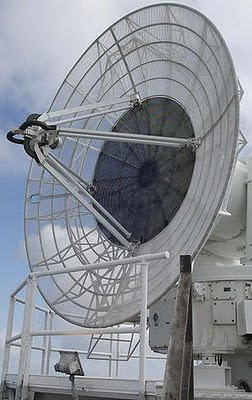The AN/FPS-16 is a C-band monopulse tracking radar used by both the US Air Force and NASA. It employs a waveguide hybrid-labyrinth comparator to develop angle track information. The comparator receives RF signals from an array of four feed horns which are located at the focal point of a 12-foot (4 m) parabolic reflector. The comparator of the AN/FPS-16 performs vector addition and subtraction of the energy received by each horn. The elevation tracking data is generated in the comparator as the difference between the sums of the top two horns. The azimuth tracking error is the difference between the sums of the two vertical horn pairs. The vectorial sums of all four horns is combined in a third channel. Three mixers with a common local oscillator, and three 30 MHz IF strips are used; one each for the azimuth, elevation, and sum signals.
The accuracy of Radar Set AN/FPS-16 is such that the position data obtained from point-source targets has azimuth and elevation angular errors of less than 0.1 milliradian (approximately 0.006 degree) and range errors of less than 5 yards (5 m) with a signal-to-noise ratio of 20 decibels or greater. The AN/FPS-16 radar system was introduced between 1958 and 1961 at the Atlantic Missile Test Range with installations including Cape Canaveral, Grand Bahama, San Salvador, Ascension and East Grand Bahama Island. The FPS-16 located on the Australian Weapons Research Establisnment Range at Woomera, in South Australia was also linked to the NASA network for Mercury and later missions. NASA Acq aid and telelmetry systems were co-located with the Australian radar. In the 1980’s WSMR started a program to move most of our FPS-16 radars from their original fixed sites into a mobile configuration. This now allows most of the radars to be moved to various sites, and when necessary throughout the world. Two radars with larger 3 Megawatt transmitters remain at fixed sites at Malone and Stallion. One other FPS-16, located at Phillips Hill, retains its original fixed site configuration.

No comments:
Post a Comment